NSB202 Report: Challenges and Solutions in Aboriginal Healthcare
VerifiedAdded on 2022/11/16
|9
|2634
|192
Report
AI Summary
This report examines a case study involving an Aboriginal patient, Matt, and the challenges he faced within the healthcare system. It explores the differences between 'Close the Gap' and 'Closing the Gap' initiatives, the funding myths surrounding Aboriginal healthcare, and the role of patient escorts, highlighting their challenges. The report emphasizes the significance of Aboriginal Hospital Liaison Officers (AHLOs) in providing culturally safe care and patient advocacy. It draws on relevant literature to analyze the complexities of Aboriginal and Torres Strait Islander healthcare, including issues of cultural safety, health disparities, and the importance of community-controlled health services. The analysis underscores the need for a holistic approach that addresses social determinants of health and promotes equitable access to healthcare services for Aboriginal and Torres Strait Islander peoples. The report provides a comprehensive overview of the issues, offering insights into the challenges and potential solutions to improve healthcare outcomes for this population.
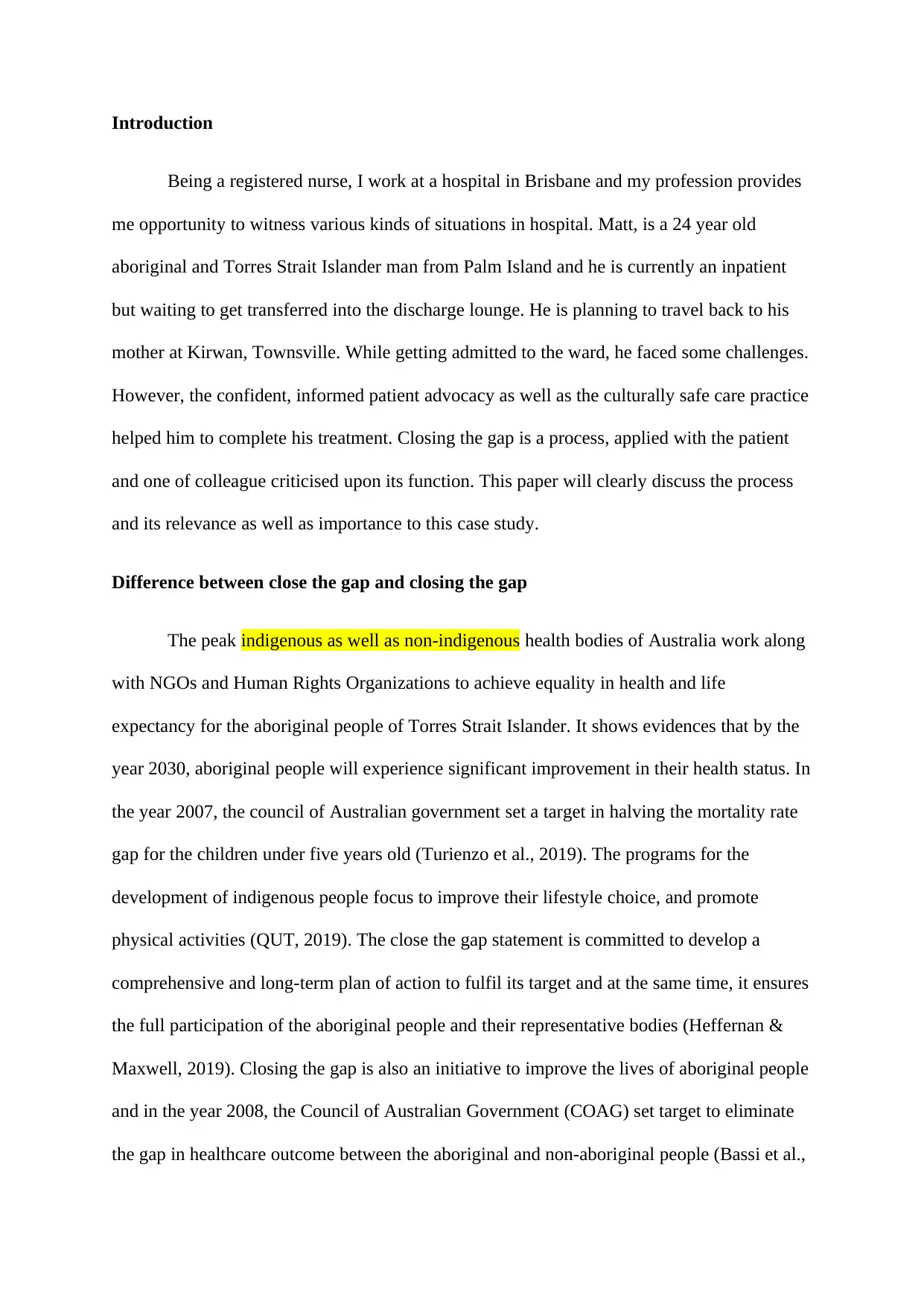
Introduction
Being a registered nurse, I work at a hospital in Brisbane and my profession provides
me opportunity to witness various kinds of situations in hospital. Matt, is a 24 year old
aboriginal and Torres Strait Islander man from Palm Island and he is currently an inpatient
but waiting to get transferred into the discharge lounge. He is planning to travel back to his
mother at Kirwan, Townsville. While getting admitted to the ward, he faced some challenges.
However, the confident, informed patient advocacy as well as the culturally safe care practice
helped him to complete his treatment. Closing the gap is a process, applied with the patient
and one of colleague criticised upon its function. This paper will clearly discuss the process
and its relevance as well as importance to this case study.
Difference between close the gap and closing the gap
The peak indigenous as well as non-indigenous health bodies of Australia work along
with NGOs and Human Rights Organizations to achieve equality in health and life
expectancy for the aboriginal people of Torres Strait Islander. It shows evidences that by the
year 2030, aboriginal people will experience significant improvement in their health status. In
the year 2007, the council of Australian government set a target in halving the mortality rate
gap for the children under five years old (Turienzo et al., 2019). The programs for the
development of indigenous people focus to improve their lifestyle choice, and promote
physical activities (QUT, 2019). The close the gap statement is committed to develop a
comprehensive and long-term plan of action to fulfil its target and at the same time, it ensures
the full participation of the aboriginal people and their representative bodies (Heffernan &
Maxwell, 2019). Closing the gap is also an initiative to improve the lives of aboriginal people
and in the year 2008, the Council of Australian Government (COAG) set target to eliminate
the gap in healthcare outcome between the aboriginal and non-aboriginal people (Bassi et al.,
Being a registered nurse, I work at a hospital in Brisbane and my profession provides
me opportunity to witness various kinds of situations in hospital. Matt, is a 24 year old
aboriginal and Torres Strait Islander man from Palm Island and he is currently an inpatient
but waiting to get transferred into the discharge lounge. He is planning to travel back to his
mother at Kirwan, Townsville. While getting admitted to the ward, he faced some challenges.
However, the confident, informed patient advocacy as well as the culturally safe care practice
helped him to complete his treatment. Closing the gap is a process, applied with the patient
and one of colleague criticised upon its function. This paper will clearly discuss the process
and its relevance as well as importance to this case study.
Difference between close the gap and closing the gap
The peak indigenous as well as non-indigenous health bodies of Australia work along
with NGOs and Human Rights Organizations to achieve equality in health and life
expectancy for the aboriginal people of Torres Strait Islander. It shows evidences that by the
year 2030, aboriginal people will experience significant improvement in their health status. In
the year 2007, the council of Australian government set a target in halving the mortality rate
gap for the children under five years old (Turienzo et al., 2019). The programs for the
development of indigenous people focus to improve their lifestyle choice, and promote
physical activities (QUT, 2019). The close the gap statement is committed to develop a
comprehensive and long-term plan of action to fulfil its target and at the same time, it ensures
the full participation of the aboriginal people and their representative bodies (Heffernan &
Maxwell, 2019). Closing the gap is also an initiative to improve the lives of aboriginal people
and in the year 2008, the Council of Australian Government (COAG) set target to eliminate
the gap in healthcare outcome between the aboriginal and non-aboriginal people (Bassi et al.,
Paraphrase This Document
Need a fresh take? Get an instant paraphrase of this document with our AI Paraphraser
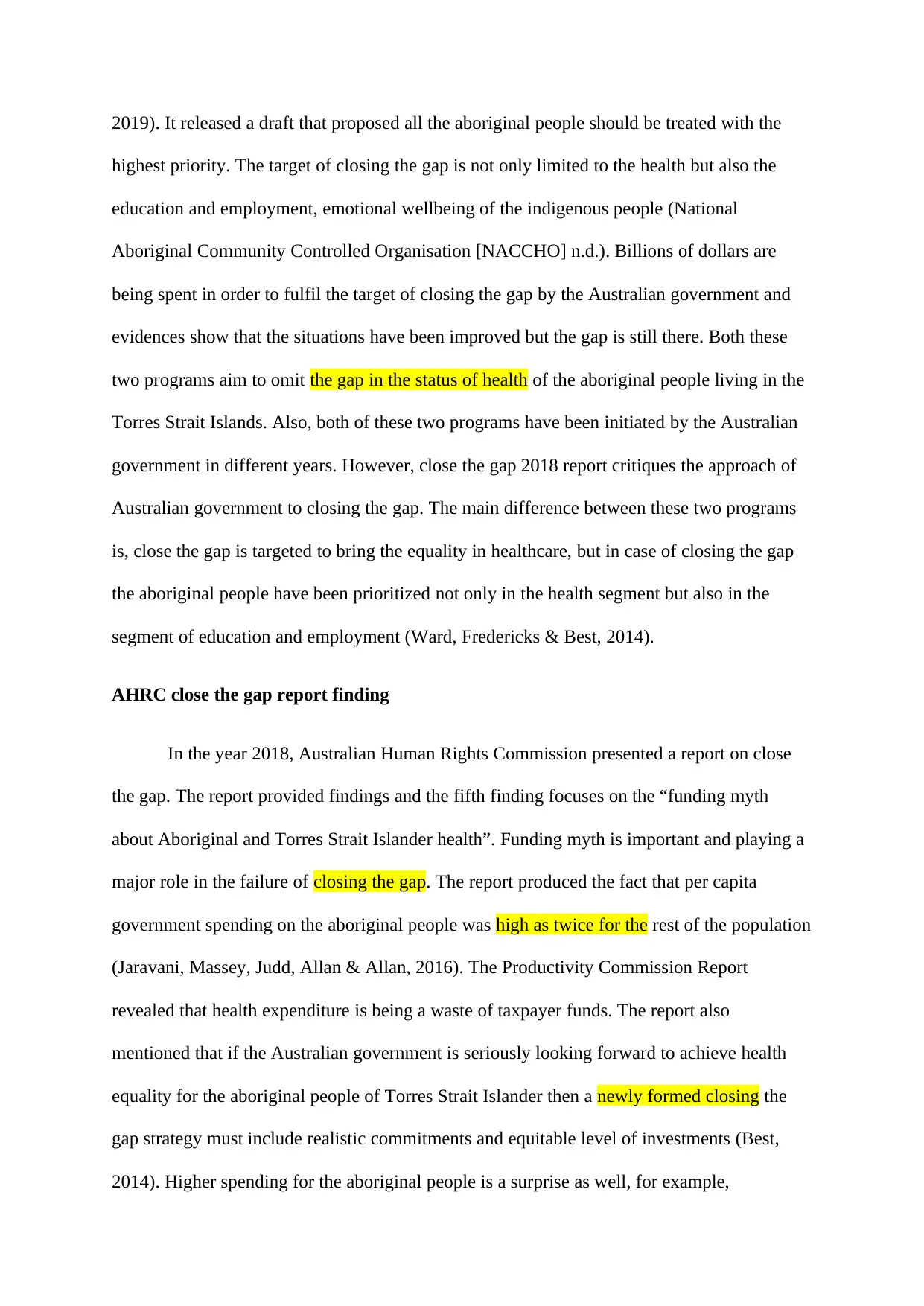
2019). It released a draft that proposed all the aboriginal people should be treated with the
highest priority. The target of closing the gap is not only limited to the health but also the
education and employment, emotional wellbeing of the indigenous people (National
Aboriginal Community Controlled Organisation [NACCHO] n.d.). Billions of dollars are
being spent in order to fulfil the target of closing the gap by the Australian government and
evidences show that the situations have been improved but the gap is still there. Both these
two programs aim to omit the gap in the status of health of the aboriginal people living in the
Torres Strait Islands. Also, both of these two programs have been initiated by the Australian
government in different years. However, close the gap 2018 report critiques the approach of
Australian government to closing the gap. The main difference between these two programs
is, close the gap is targeted to bring the equality in healthcare, but in case of closing the gap
the aboriginal people have been prioritized not only in the health segment but also in the
segment of education and employment (Ward, Fredericks & Best, 2014).
AHRC close the gap report finding
In the year 2018, Australian Human Rights Commission presented a report on close
the gap. The report provided findings and the fifth finding focuses on the “funding myth
about Aboriginal and Torres Strait Islander health”. Funding myth is important and playing a
major role in the failure of closing the gap. The report produced the fact that per capita
government spending on the aboriginal people was high as twice for the rest of the population
(Jaravani, Massey, Judd, Allan & Allan, 2016). The Productivity Commission Report
revealed that health expenditure is being a waste of taxpayer funds. The report also
mentioned that if the Australian government is seriously looking forward to achieve health
equality for the aboriginal people of Torres Strait Islander then a newly formed closing the
gap strategy must include realistic commitments and equitable level of investments (Best,
2014). Higher spending for the aboriginal people is a surprise as well, for example,
highest priority. The target of closing the gap is not only limited to the health but also the
education and employment, emotional wellbeing of the indigenous people (National
Aboriginal Community Controlled Organisation [NACCHO] n.d.). Billions of dollars are
being spent in order to fulfil the target of closing the gap by the Australian government and
evidences show that the situations have been improved but the gap is still there. Both these
two programs aim to omit the gap in the status of health of the aboriginal people living in the
Torres Strait Islands. Also, both of these two programs have been initiated by the Australian
government in different years. However, close the gap 2018 report critiques the approach of
Australian government to closing the gap. The main difference between these two programs
is, close the gap is targeted to bring the equality in healthcare, but in case of closing the gap
the aboriginal people have been prioritized not only in the health segment but also in the
segment of education and employment (Ward, Fredericks & Best, 2014).
AHRC close the gap report finding
In the year 2018, Australian Human Rights Commission presented a report on close
the gap. The report provided findings and the fifth finding focuses on the “funding myth
about Aboriginal and Torres Strait Islander health”. Funding myth is important and playing a
major role in the failure of closing the gap. The report produced the fact that per capita
government spending on the aboriginal people was high as twice for the rest of the population
(Jaravani, Massey, Judd, Allan & Allan, 2016). The Productivity Commission Report
revealed that health expenditure is being a waste of taxpayer funds. The report also
mentioned that if the Australian government is seriously looking forward to achieve health
equality for the aboriginal people of Torres Strait Islander then a newly formed closing the
gap strategy must include realistic commitments and equitable level of investments (Best,
2014). Higher spending for the aboriginal people is a surprise as well, for example,
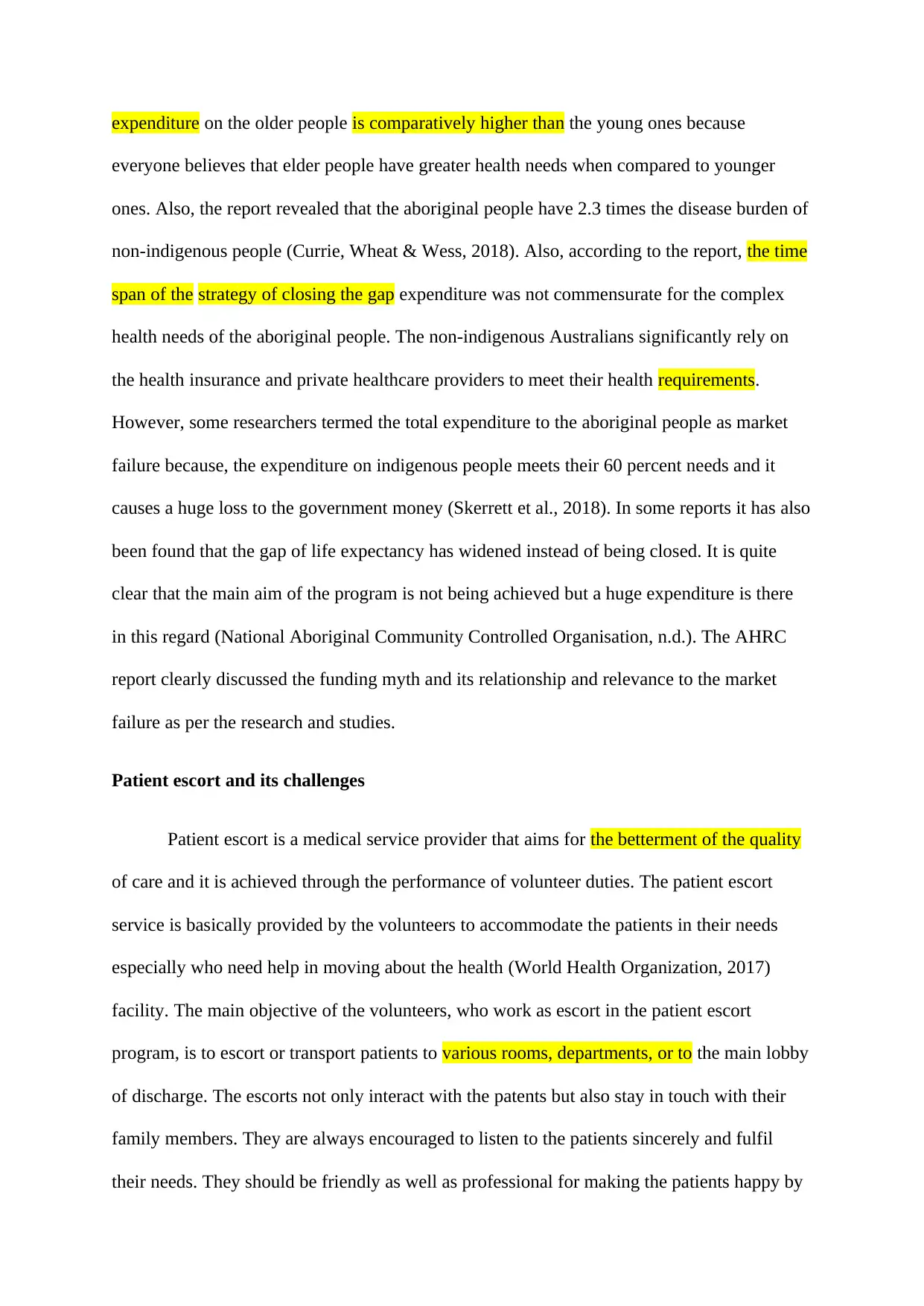
expenditure on the older people is comparatively higher than the young ones because
everyone believes that elder people have greater health needs when compared to younger
ones. Also, the report revealed that the aboriginal people have 2.3 times the disease burden of
non-indigenous people (Currie, Wheat & Wess, 2018). Also, according to the report, the time
span of the strategy of closing the gap expenditure was not commensurate for the complex
health needs of the aboriginal people. The non-indigenous Australians significantly rely on
the health insurance and private healthcare providers to meet their health requirements.
However, some researchers termed the total expenditure to the aboriginal people as market
failure because, the expenditure on indigenous people meets their 60 percent needs and it
causes a huge loss to the government money (Skerrett et al., 2018). In some reports it has also
been found that the gap of life expectancy has widened instead of being closed. It is quite
clear that the main aim of the program is not being achieved but a huge expenditure is there
in this regard (National Aboriginal Community Controlled Organisation, n.d.). The AHRC
report clearly discussed the funding myth and its relationship and relevance to the market
failure as per the research and studies.
Patient escort and its challenges
Patient escort is a medical service provider that aims for the betterment of the quality
of care and it is achieved through the performance of volunteer duties. The patient escort
service is basically provided by the volunteers to accommodate the patients in their needs
especially who need help in moving about the health (World Health Organization, 2017)
facility. The main objective of the volunteers, who work as escort in the patient escort
program, is to escort or transport patients to various rooms, departments, or to the main lobby
of discharge. The escorts not only interact with the patents but also stay in touch with their
family members. They are always encouraged to listen to the patients sincerely and fulfil
their needs. They should be friendly as well as professional for making the patients happy by
everyone believes that elder people have greater health needs when compared to younger
ones. Also, the report revealed that the aboriginal people have 2.3 times the disease burden of
non-indigenous people (Currie, Wheat & Wess, 2018). Also, according to the report, the time
span of the strategy of closing the gap expenditure was not commensurate for the complex
health needs of the aboriginal people. The non-indigenous Australians significantly rely on
the health insurance and private healthcare providers to meet their health requirements.
However, some researchers termed the total expenditure to the aboriginal people as market
failure because, the expenditure on indigenous people meets their 60 percent needs and it
causes a huge loss to the government money (Skerrett et al., 2018). In some reports it has also
been found that the gap of life expectancy has widened instead of being closed. It is quite
clear that the main aim of the program is not being achieved but a huge expenditure is there
in this regard (National Aboriginal Community Controlled Organisation, n.d.). The AHRC
report clearly discussed the funding myth and its relationship and relevance to the market
failure as per the research and studies.
Patient escort and its challenges
Patient escort is a medical service provider that aims for the betterment of the quality
of care and it is achieved through the performance of volunteer duties. The patient escort
service is basically provided by the volunteers to accommodate the patients in their needs
especially who need help in moving about the health (World Health Organization, 2017)
facility. The main objective of the volunteers, who work as escort in the patient escort
program, is to escort or transport patients to various rooms, departments, or to the main lobby
of discharge. The escorts not only interact with the patents but also stay in touch with their
family members. They are always encouraged to listen to the patients sincerely and fulfil
their needs. They should be friendly as well as professional for making the patients happy by
⊘ This is a preview!⊘
Do you want full access?
Subscribe today to unlock all pages.

Trusted by 1+ million students worldwide
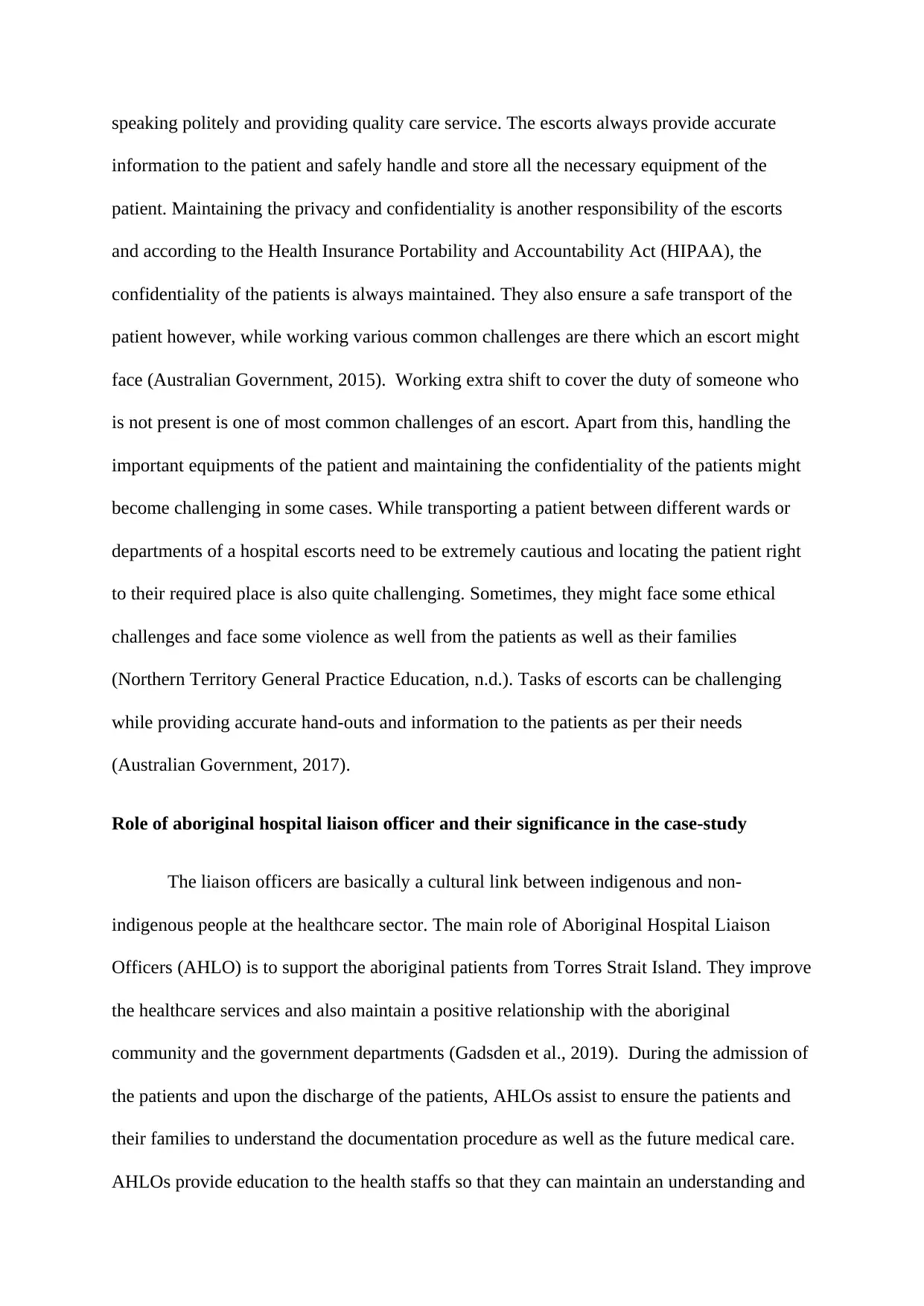
speaking politely and providing quality care service. The escorts always provide accurate
information to the patient and safely handle and store all the necessary equipment of the
patient. Maintaining the privacy and confidentiality is another responsibility of the escorts
and according to the Health Insurance Portability and Accountability Act (HIPAA), the
confidentiality of the patients is always maintained. They also ensure a safe transport of the
patient however, while working various common challenges are there which an escort might
face (Australian Government, 2015). Working extra shift to cover the duty of someone who
is not present is one of most common challenges of an escort. Apart from this, handling the
important equipments of the patient and maintaining the confidentiality of the patients might
become challenging in some cases. While transporting a patient between different wards or
departments of a hospital escorts need to be extremely cautious and locating the patient right
to their required place is also quite challenging. Sometimes, they might face some ethical
challenges and face some violence as well from the patients as well as their families
(Northern Territory General Practice Education, n.d.). Tasks of escorts can be challenging
while providing accurate hand-outs and information to the patients as per their needs
(Australian Government, 2017).
Role of aboriginal hospital liaison officer and their significance in the case-study
The liaison officers are basically a cultural link between indigenous and non-
indigenous people at the healthcare sector. The main role of Aboriginal Hospital Liaison
Officers (AHLO) is to support the aboriginal patients from Torres Strait Island. They improve
the healthcare services and also maintain a positive relationship with the aboriginal
community and the government departments (Gadsden et al., 2019). During the admission of
the patients and upon the discharge of the patients, AHLOs assist to ensure the patients and
their families to understand the documentation procedure as well as the future medical care.
AHLOs provide education to the health staffs so that they can maintain an understanding and
information to the patient and safely handle and store all the necessary equipment of the
patient. Maintaining the privacy and confidentiality is another responsibility of the escorts
and according to the Health Insurance Portability and Accountability Act (HIPAA), the
confidentiality of the patients is always maintained. They also ensure a safe transport of the
patient however, while working various common challenges are there which an escort might
face (Australian Government, 2015). Working extra shift to cover the duty of someone who
is not present is one of most common challenges of an escort. Apart from this, handling the
important equipments of the patient and maintaining the confidentiality of the patients might
become challenging in some cases. While transporting a patient between different wards or
departments of a hospital escorts need to be extremely cautious and locating the patient right
to their required place is also quite challenging. Sometimes, they might face some ethical
challenges and face some violence as well from the patients as well as their families
(Northern Territory General Practice Education, n.d.). Tasks of escorts can be challenging
while providing accurate hand-outs and information to the patients as per their needs
(Australian Government, 2017).
Role of aboriginal hospital liaison officer and their significance in the case-study
The liaison officers are basically a cultural link between indigenous and non-
indigenous people at the healthcare sector. The main role of Aboriginal Hospital Liaison
Officers (AHLO) is to support the aboriginal patients from Torres Strait Island. They improve
the healthcare services and also maintain a positive relationship with the aboriginal
community and the government departments (Gadsden et al., 2019). During the admission of
the patients and upon the discharge of the patients, AHLOs assist to ensure the patients and
their families to understand the documentation procedure as well as the future medical care.
AHLOs provide education to the health staffs so that they can maintain an understanding and
Paraphrase This Document
Need a fresh take? Get an instant paraphrase of this document with our AI Paraphraser
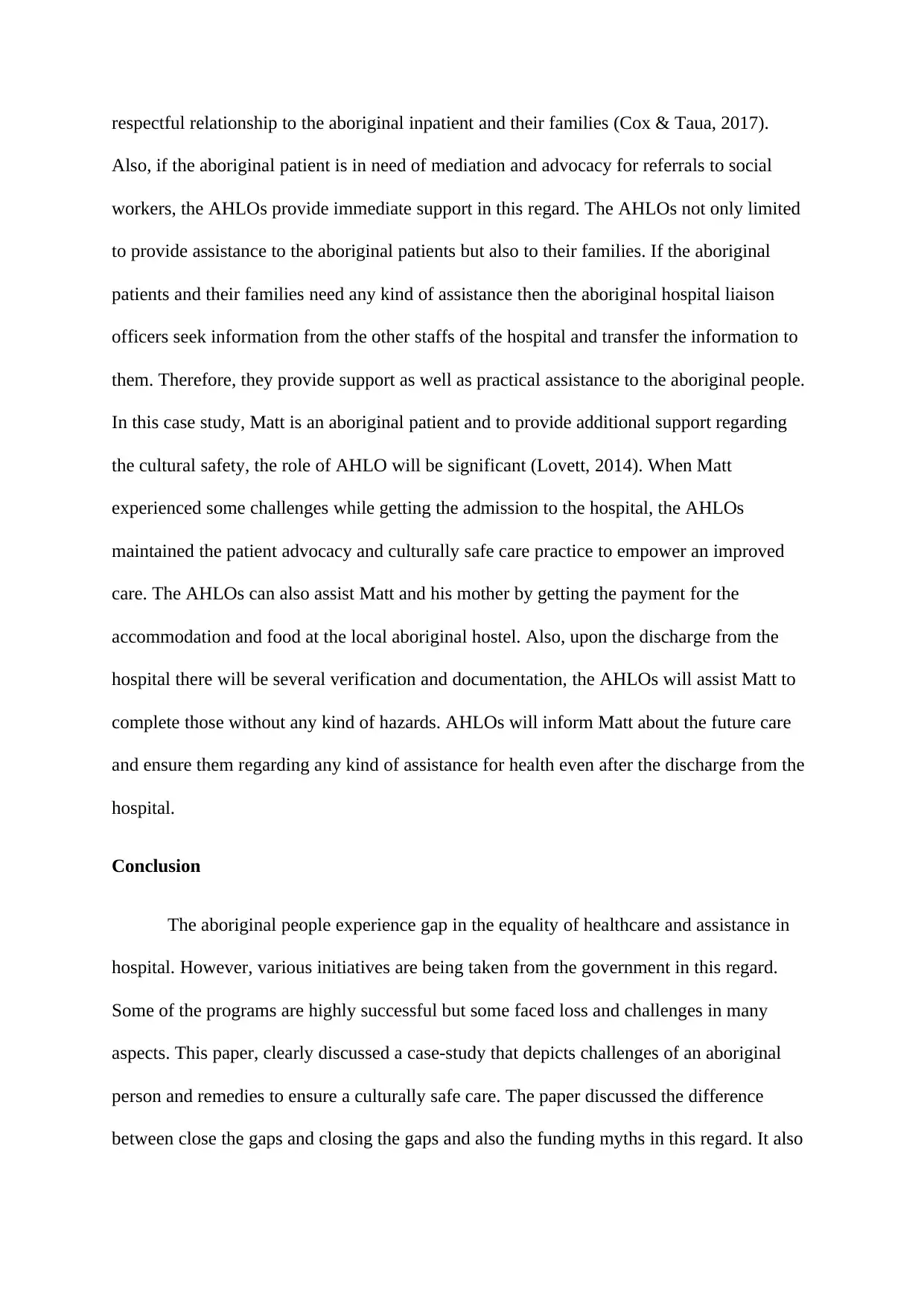
respectful relationship to the aboriginal inpatient and their families (Cox & Taua, 2017).
Also, if the aboriginal patient is in need of mediation and advocacy for referrals to social
workers, the AHLOs provide immediate support in this regard. The AHLOs not only limited
to provide assistance to the aboriginal patients but also to their families. If the aboriginal
patients and their families need any kind of assistance then the aboriginal hospital liaison
officers seek information from the other staffs of the hospital and transfer the information to
them. Therefore, they provide support as well as practical assistance to the aboriginal people.
In this case study, Matt is an aboriginal patient and to provide additional support regarding
the cultural safety, the role of AHLO will be significant (Lovett, 2014). When Matt
experienced some challenges while getting the admission to the hospital, the AHLOs
maintained the patient advocacy and culturally safe care practice to empower an improved
care. The AHLOs can also assist Matt and his mother by getting the payment for the
accommodation and food at the local aboriginal hostel. Also, upon the discharge from the
hospital there will be several verification and documentation, the AHLOs will assist Matt to
complete those without any kind of hazards. AHLOs will inform Matt about the future care
and ensure them regarding any kind of assistance for health even after the discharge from the
hospital.
Conclusion
The aboriginal people experience gap in the equality of healthcare and assistance in
hospital. However, various initiatives are being taken from the government in this regard.
Some of the programs are highly successful but some faced loss and challenges in many
aspects. This paper, clearly discussed a case-study that depicts challenges of an aboriginal
person and remedies to ensure a culturally safe care. The paper discussed the difference
between close the gaps and closing the gaps and also the funding myths in this regard. It also
Also, if the aboriginal patient is in need of mediation and advocacy for referrals to social
workers, the AHLOs provide immediate support in this regard. The AHLOs not only limited
to provide assistance to the aboriginal patients but also to their families. If the aboriginal
patients and their families need any kind of assistance then the aboriginal hospital liaison
officers seek information from the other staffs of the hospital and transfer the information to
them. Therefore, they provide support as well as practical assistance to the aboriginal people.
In this case study, Matt is an aboriginal patient and to provide additional support regarding
the cultural safety, the role of AHLO will be significant (Lovett, 2014). When Matt
experienced some challenges while getting the admission to the hospital, the AHLOs
maintained the patient advocacy and culturally safe care practice to empower an improved
care. The AHLOs can also assist Matt and his mother by getting the payment for the
accommodation and food at the local aboriginal hostel. Also, upon the discharge from the
hospital there will be several verification and documentation, the AHLOs will assist Matt to
complete those without any kind of hazards. AHLOs will inform Matt about the future care
and ensure them regarding any kind of assistance for health even after the discharge from the
hospital.
Conclusion
The aboriginal people experience gap in the equality of healthcare and assistance in
hospital. However, various initiatives are being taken from the government in this regard.
Some of the programs are highly successful but some faced loss and challenges in many
aspects. This paper, clearly discussed a case-study that depicts challenges of an aboriginal
person and remedies to ensure a culturally safe care. The paper discussed the difference
between close the gaps and closing the gaps and also the funding myths in this regard. It also
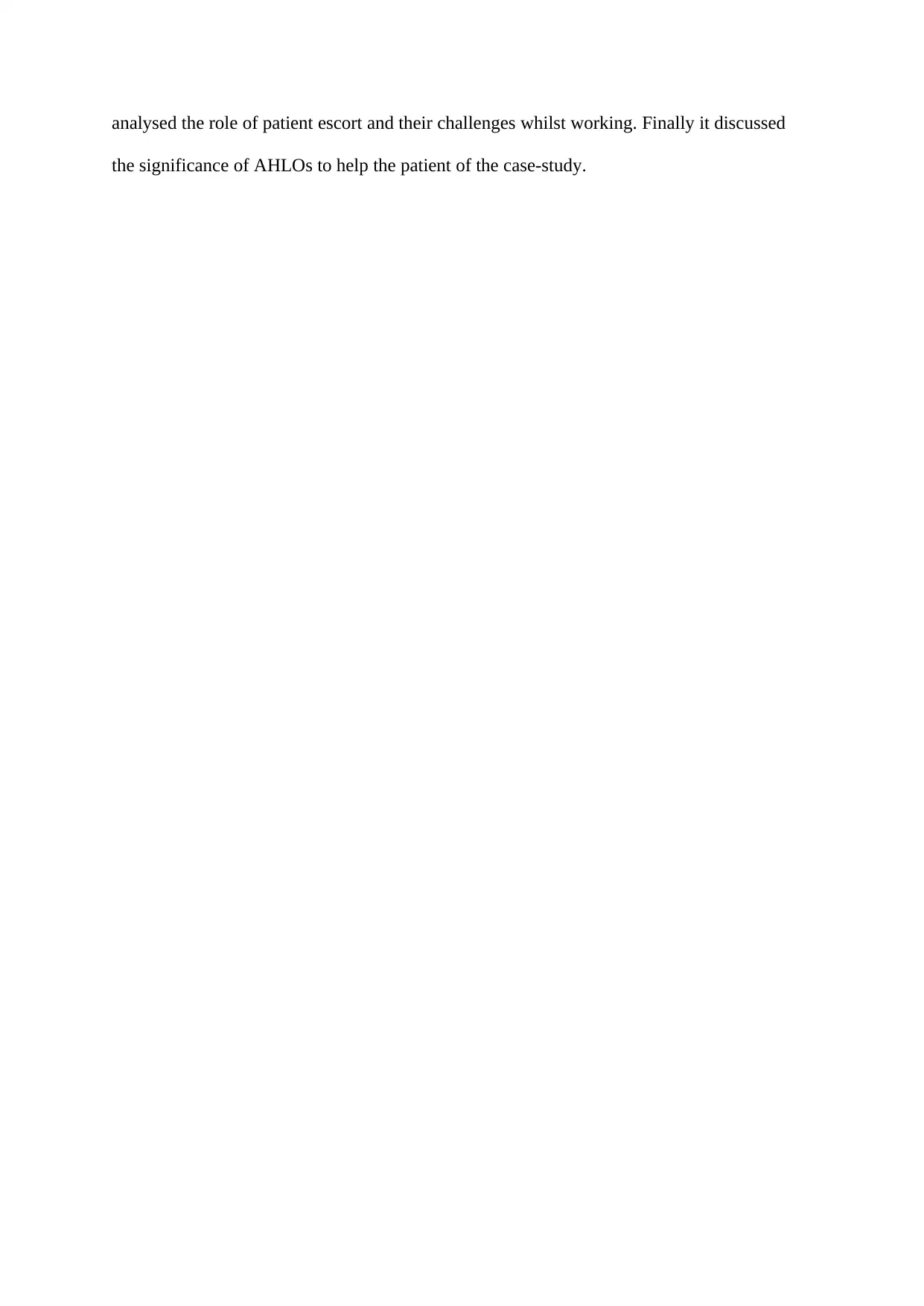
analysed the role of patient escort and their challenges whilst working. Finally it discussed
the significance of AHLOs to help the patient of the case-study.
the significance of AHLOs to help the patient of the case-study.
⊘ This is a preview!⊘
Do you want full access?
Subscribe today to unlock all pages.

Trusted by 1+ million students worldwide
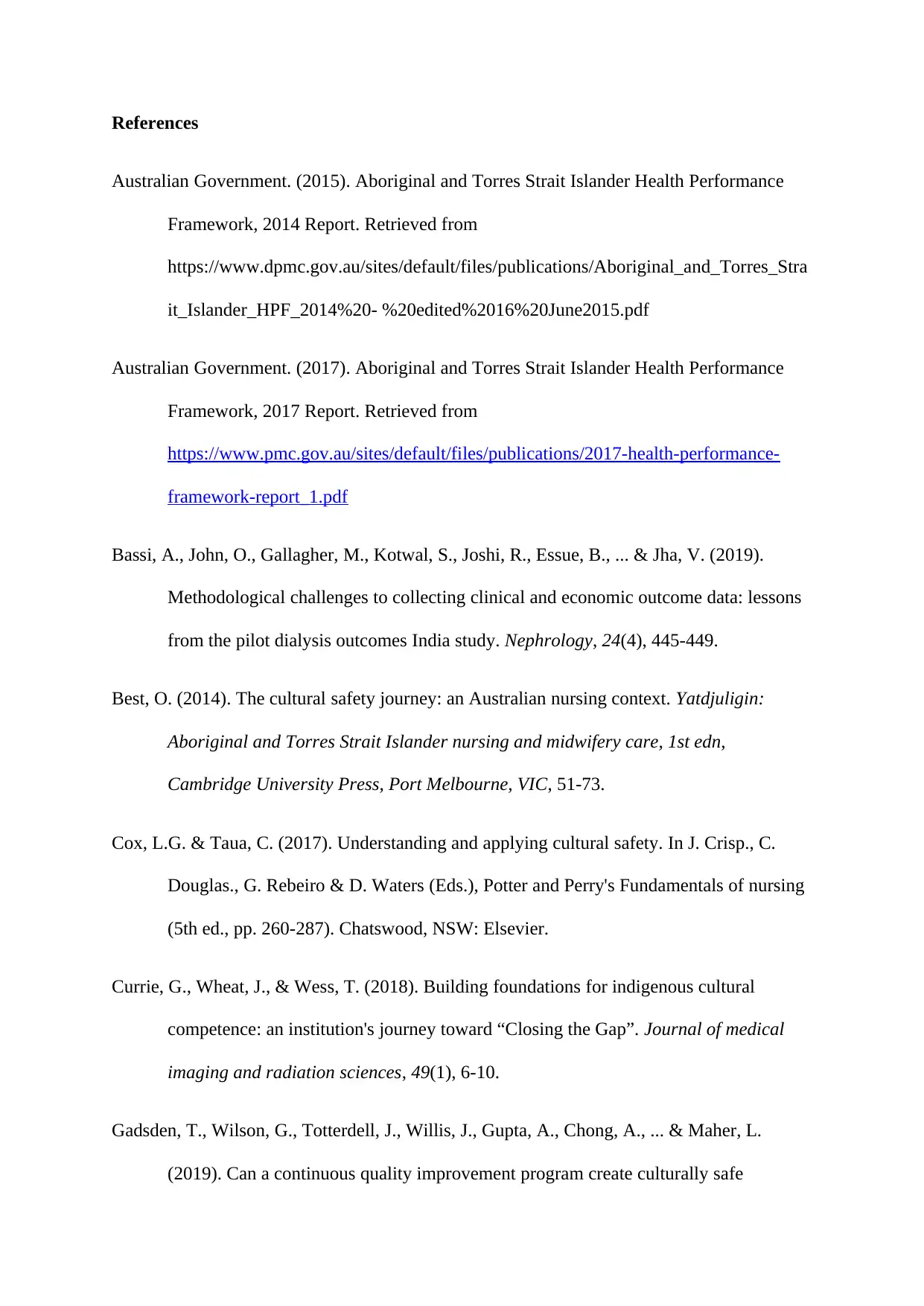
References
Australian Government. (2015). Aboriginal and Torres Strait Islander Health Performance
Framework, 2014 Report. Retrieved from
https://www.dpmc.gov.au/sites/default/files/publications/Aboriginal_and_Torres_Stra
it_Islander_HPF_2014%20- %20edited%2016%20June2015.pdf
Australian Government. (2017). Aboriginal and Torres Strait Islander Health Performance
Framework, 2017 Report. Retrieved from
https://www.pmc.gov.au/sites/default/files/publications/2017-health-performance-
framework-report_1.pdf
Bassi, A., John, O., Gallagher, M., Kotwal, S., Joshi, R., Essue, B., ... & Jha, V. (2019).
Methodological challenges to collecting clinical and economic outcome data: lessons
from the pilot dialysis outcomes India study. Nephrology, 24(4), 445-449.
Best, O. (2014). The cultural safety journey: an Australian nursing context. Yatdjuligin:
Aboriginal and Torres Strait Islander nursing and midwifery care, 1st edn,
Cambridge University Press, Port Melbourne, VIC, 51-73.
Cox, L.G. & Taua, C. (2017). Understanding and applying cultural safety. In J. Crisp., C.
Douglas., G. Rebeiro & D. Waters (Eds.), Potter and Perry's Fundamentals of nursing
(5th ed., pp. 260-287). Chatswood, NSW: Elsevier.
Currie, G., Wheat, J., & Wess, T. (2018). Building foundations for indigenous cultural
competence: an institution's journey toward “Closing the Gap”. Journal of medical
imaging and radiation sciences, 49(1), 6-10.
Gadsden, T., Wilson, G., Totterdell, J., Willis, J., Gupta, A., Chong, A., ... & Maher, L.
(2019). Can a continuous quality improvement program create culturally safe
Australian Government. (2015). Aboriginal and Torres Strait Islander Health Performance
Framework, 2014 Report. Retrieved from
https://www.dpmc.gov.au/sites/default/files/publications/Aboriginal_and_Torres_Stra
it_Islander_HPF_2014%20- %20edited%2016%20June2015.pdf
Australian Government. (2017). Aboriginal and Torres Strait Islander Health Performance
Framework, 2017 Report. Retrieved from
https://www.pmc.gov.au/sites/default/files/publications/2017-health-performance-
framework-report_1.pdf
Bassi, A., John, O., Gallagher, M., Kotwal, S., Joshi, R., Essue, B., ... & Jha, V. (2019).
Methodological challenges to collecting clinical and economic outcome data: lessons
from the pilot dialysis outcomes India study. Nephrology, 24(4), 445-449.
Best, O. (2014). The cultural safety journey: an Australian nursing context. Yatdjuligin:
Aboriginal and Torres Strait Islander nursing and midwifery care, 1st edn,
Cambridge University Press, Port Melbourne, VIC, 51-73.
Cox, L.G. & Taua, C. (2017). Understanding and applying cultural safety. In J. Crisp., C.
Douglas., G. Rebeiro & D. Waters (Eds.), Potter and Perry's Fundamentals of nursing
(5th ed., pp. 260-287). Chatswood, NSW: Elsevier.
Currie, G., Wheat, J., & Wess, T. (2018). Building foundations for indigenous cultural
competence: an institution's journey toward “Closing the Gap”. Journal of medical
imaging and radiation sciences, 49(1), 6-10.
Gadsden, T., Wilson, G., Totterdell, J., Willis, J., Gupta, A., Chong, A., ... & Maher, L.
(2019). Can a continuous quality improvement program create culturally safe
Paraphrase This Document
Need a fresh take? Get an instant paraphrase of this document with our AI Paraphraser
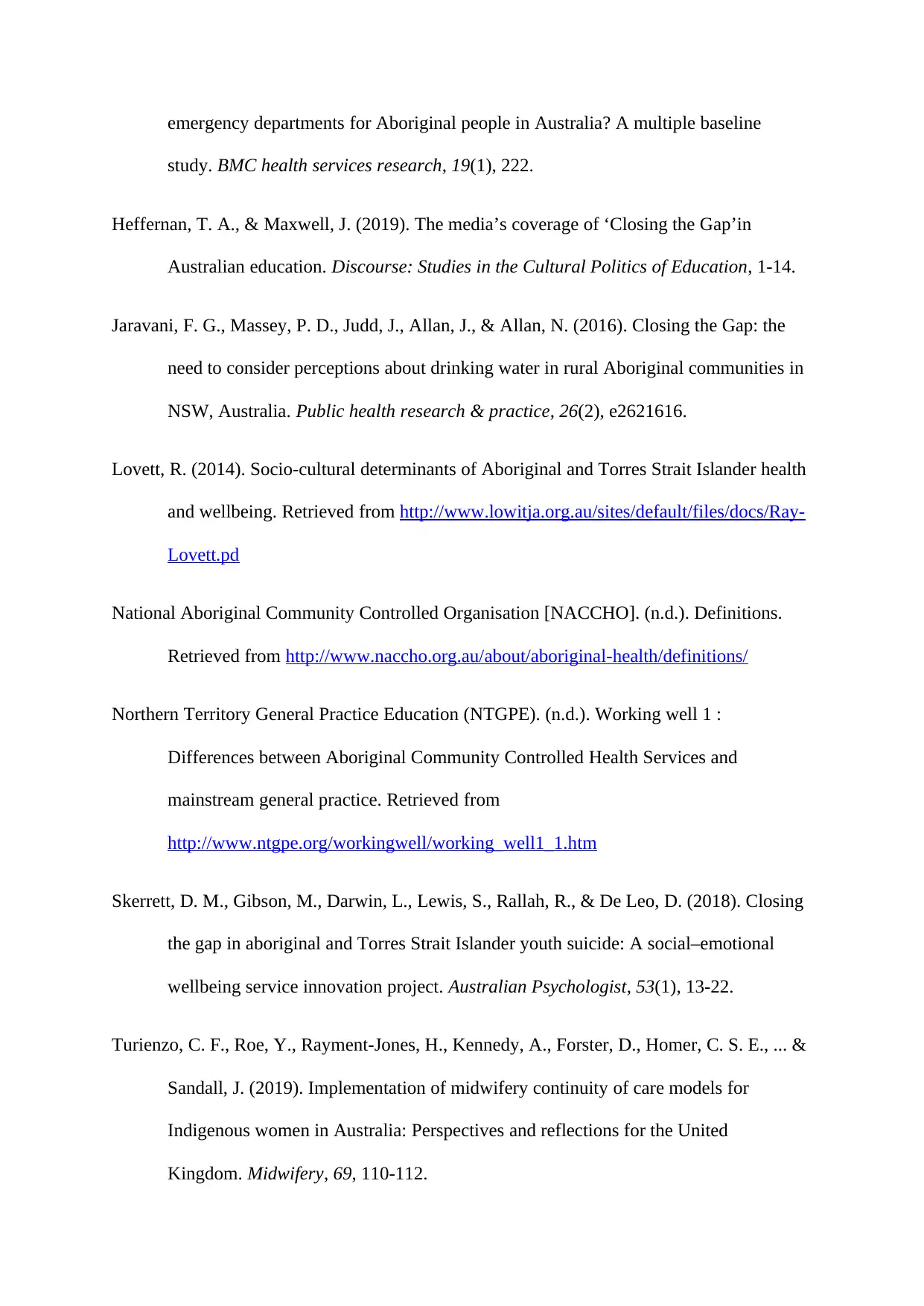
emergency departments for Aboriginal people in Australia? A multiple baseline
study. BMC health services research, 19(1), 222.
Heffernan, T. A., & Maxwell, J. (2019). The media’s coverage of ‘Closing the Gap’in
Australian education. Discourse: Studies in the Cultural Politics of Education, 1-14.
Jaravani, F. G., Massey, P. D., Judd, J., Allan, J., & Allan, N. (2016). Closing the Gap: the
need to consider perceptions about drinking water in rural Aboriginal communities in
NSW, Australia. Public health research & practice, 26(2), e2621616.
Lovett, R. (2014). Socio-cultural determinants of Aboriginal and Torres Strait Islander health
and wellbeing. Retrieved from http://www.lowitja.org.au/sites/default/files/docs/Ray-
Lovett.pd
National Aboriginal Community Controlled Organisation [NACCHO]. (n.d.). Definitions.
Retrieved from http://www.naccho.org.au/about/aboriginal-health/definitions/
Northern Territory General Practice Education (NTGPE). (n.d.). Working well 1 :
Differences between Aboriginal Community Controlled Health Services and
mainstream general practice. Retrieved from
http://www.ntgpe.org/workingwell/working_well1_1.htm
Skerrett, D. M., Gibson, M., Darwin, L., Lewis, S., Rallah, R., & De Leo, D. (2018). Closing
the gap in aboriginal and Torres Strait Islander youth suicide: A social–emotional
wellbeing service innovation project. Australian Psychologist, 53(1), 13-22.
Turienzo, C. F., Roe, Y., Rayment-Jones, H., Kennedy, A., Forster, D., Homer, C. S. E., ... &
Sandall, J. (2019). Implementation of midwifery continuity of care models for
Indigenous women in Australia: Perspectives and reflections for the United
Kingdom. Midwifery, 69, 110-112.
study. BMC health services research, 19(1), 222.
Heffernan, T. A., & Maxwell, J. (2019). The media’s coverage of ‘Closing the Gap’in
Australian education. Discourse: Studies in the Cultural Politics of Education, 1-14.
Jaravani, F. G., Massey, P. D., Judd, J., Allan, J., & Allan, N. (2016). Closing the Gap: the
need to consider perceptions about drinking water in rural Aboriginal communities in
NSW, Australia. Public health research & practice, 26(2), e2621616.
Lovett, R. (2014). Socio-cultural determinants of Aboriginal and Torres Strait Islander health
and wellbeing. Retrieved from http://www.lowitja.org.au/sites/default/files/docs/Ray-
Lovett.pd
National Aboriginal Community Controlled Organisation [NACCHO]. (n.d.). Definitions.
Retrieved from http://www.naccho.org.au/about/aboriginal-health/definitions/
Northern Territory General Practice Education (NTGPE). (n.d.). Working well 1 :
Differences between Aboriginal Community Controlled Health Services and
mainstream general practice. Retrieved from
http://www.ntgpe.org/workingwell/working_well1_1.htm
Skerrett, D. M., Gibson, M., Darwin, L., Lewis, S., Rallah, R., & De Leo, D. (2018). Closing
the gap in aboriginal and Torres Strait Islander youth suicide: A social–emotional
wellbeing service innovation project. Australian Psychologist, 53(1), 13-22.
Turienzo, C. F., Roe, Y., Rayment-Jones, H., Kennedy, A., Forster, D., Homer, C. S. E., ... &
Sandall, J. (2019). Implementation of midwifery continuity of care models for
Indigenous women in Australia: Perspectives and reflections for the United
Kingdom. Midwifery, 69, 110-112.
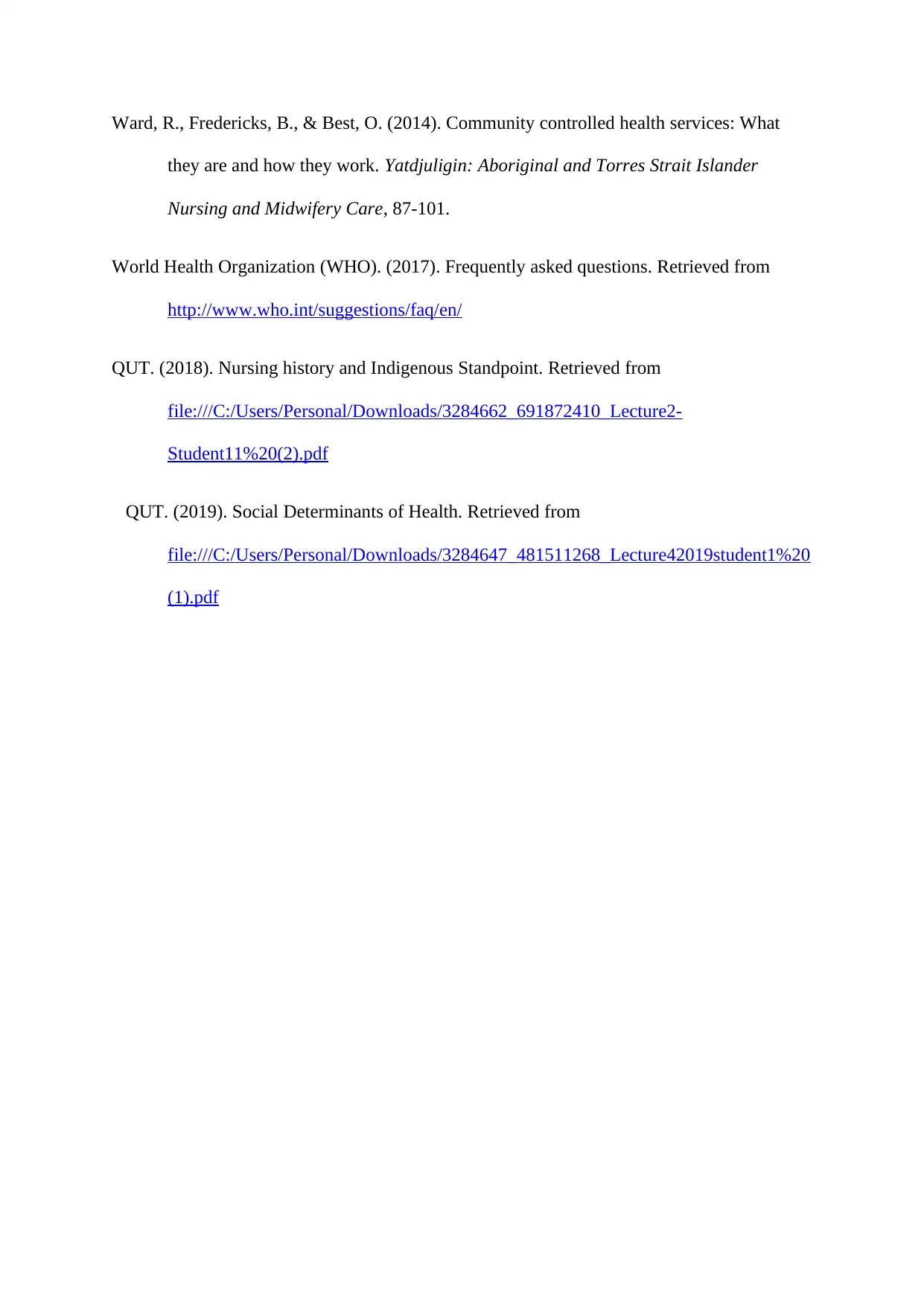
Ward, R., Fredericks, B., & Best, O. (2014). Community controlled health services: What
they are and how they work. Yatdjuligin: Aboriginal and Torres Strait Islander
Nursing and Midwifery Care, 87-101.
World Health Organization (WHO). (2017). Frequently asked questions. Retrieved from
http://www.who.int/suggestions/faq/en/
QUT. (2018). Nursing history and Indigenous Standpoint. Retrieved from
file:///C:/Users/Personal/Downloads/3284662_691872410_Lecture2-
Student11%20(2).pdf
QUT. (2019). Social Determinants of Health. Retrieved from
file:///C:/Users/Personal/Downloads/3284647_481511268_Lecture42019student1%20
(1).pdf
they are and how they work. Yatdjuligin: Aboriginal and Torres Strait Islander
Nursing and Midwifery Care, 87-101.
World Health Organization (WHO). (2017). Frequently asked questions. Retrieved from
http://www.who.int/suggestions/faq/en/
QUT. (2018). Nursing history and Indigenous Standpoint. Retrieved from
file:///C:/Users/Personal/Downloads/3284662_691872410_Lecture2-
Student11%20(2).pdf
QUT. (2019). Social Determinants of Health. Retrieved from
file:///C:/Users/Personal/Downloads/3284647_481511268_Lecture42019student1%20
(1).pdf
⊘ This is a preview!⊘
Do you want full access?
Subscribe today to unlock all pages.

Trusted by 1+ million students worldwide
1 out of 9
Related Documents
Your All-in-One AI-Powered Toolkit for Academic Success.
+13062052269
info@desklib.com
Available 24*7 on WhatsApp / Email
![[object Object]](/_next/static/media/star-bottom.7253800d.svg)
Unlock your academic potential
Copyright © 2020–2025 A2Z Services. All Rights Reserved. Developed and managed by ZUCOL.





